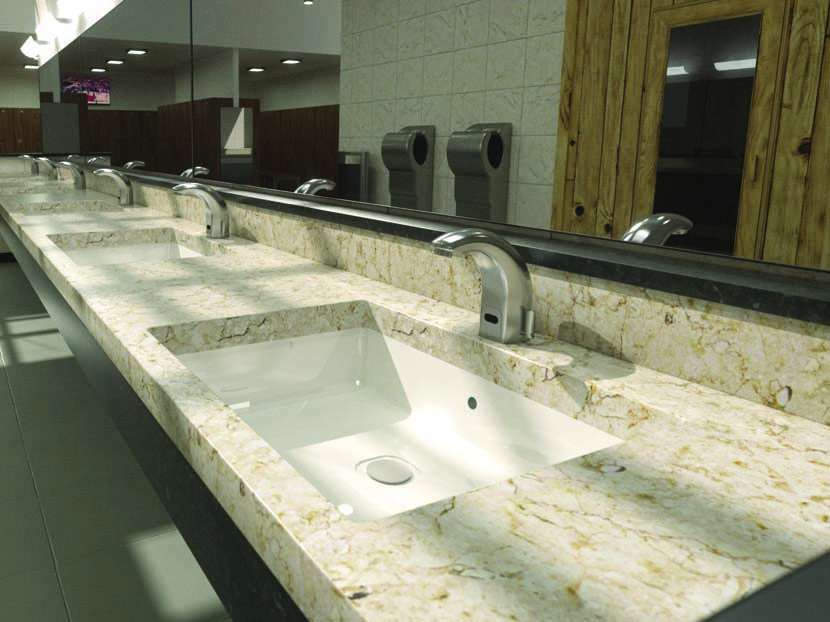To Sense or Not to Sense
The pros and cons of using hands-free faucets in a facility.

Even as hands-free sensor faucets continue to proliferate across nearly every kind of facility, questions remain about when and where sensor faucets belong — and where they may not.
Often selected for their sustainability, efficiency and hygienic benefits, sensor faucets offer some operational perks. But they’re not necessarily for everyone. Consider the pros and cons before making the switch from traditional manual faucets to sensor faucets.
When to go hands-free
1. You’re boosting your sustainability cred. Going green (or greener) is a widespread motivation as companies seek to reduce their impact on the environment and cultivate goodwill in the process.
By running water only when it’s needed, sensor faucets can save up to one gallon of water for each handwash over traditional manual faucets. When you multiply the number of sinks and the individuals using them, the overall impact can be dramatic. Add in associated energy to heat the water, and the ramifications increase further.
Reducing the demand for these valuable resources not only improves sustainability, it also leads to financial savings through reduced water, energy and sewer costs.
2. You want to improve hygiene. Sensor faucets improve hygiene in some obvious ways — such as eliminating a touchpoint in restrooms — as well as some less-obvious ones tied to human behavior.
A Centers for Disease Control and Prevention (CDC) study shows food workers washed their hands in only about a quarter of the situations that should have involved handwashing. The belief that handwashing takes too much time was among the potential reasons cited for the gap.
Another CDC study reveals that sink accessibility was related to handwashing, which suggests the sink’s ease of use can play a role in appropriate handwashing.
Sensor faucets streamline basic water access, making turning on the water as easy as stepping up to a sink and reducing the perception of handwashing as a time-consuming activity, which may invite more frequent handwashing. This ease of use may boost hygienic behaviors, particularly in critical applications such as foodservice.
3. You want to class up the joint. Sensor faucets provide a high-end feel that manual faucets can’t match.
When sensor technology first appeared in the marketplace, the faucets were expensive and typically installed only as a state-of-the-art luxury or novelty. As technology has improved and prices have come down in recent years, sensor faucets have become more widespread but still carry a high-end feel to them.
Particularly in public facilities such as offices, airports and event venues, users have not only become comfortable with touch-free technologies, they have come to expect the modern, sleek and clean feel they offer.
When not to go hands-free
1. You work in a school. Environments where vandalism can be a common problem — and let’s be honest about the general tendencies of middle-school students — may not be ideal for sensor faucets. Users may try to damage the sensor by scratching it, making the faucet less effective at sensing when to activate water flow.
Likewise, institutional applications such as prisons or K-12 schools may find the slightly higher cost of sensor faucets unjustifiable and favor other water-saving, rugged options such as self-closing metering faucets.
2. You’re trying to keep the maintenance staff clocking overtime single-handedly. Sensor faucets are easy to install, low-maintenance and resist the kind of tampering that can require regular attention from custodial or maintenance staff. With an automatic shut-off feature, there’s no opportunity for a negligent user to leave the water running. And the time-out settings also prevent any vandalism-driven efforts to make water run by covering or otherwise manipulating the activating sensor.
High-quality sensor faucets are designed to run for years with only minor maintenance. And installing hydro generators, which harness the power of water flow to run the faucet, reduces maintenance needs further by eliminating the need to change batteries.
3. You’re experimenting the transmissibility of germs. Hygiene experts recommend faucets be turned off using a paper towel or elbow, rather than having newly cleaned hands reach for a faucet handle that was only moments before turned on by soiled hands. While it’s good advice, it’s often unknown or ignored in real-life scenarios.
Sensor faucets eliminate that potentially contaminating touchpoint, reducing the possibility of transmission of germs from faucet handles. In fact, a 2017 U.S. Food and Drug Administration study of restaurants — published in Risk Analysis, the scholarly journal of the Society for Risk Analysis — reveals that touchless faucets and doors are more efficient in reducing the number of infected customers than other methods.
4. You’re paralyzed by choice. Sensor faucets are highly customizable to meet specific facility needs.
Some commonly available options include above- or below-deck electronics to allow for desired accessibility, flow rates ranging from standard to water-sipping for the right balance of performance and sustainability, and power source options that can ensure uninterrupted service even in the event of power loss or battery failure.
And the number of shapes and sizes of available sensor faucets have increased dramatically in the past few years as the market has ramped up its interest. Manufacturers have worked to meet demands by creating streamlined, more desirable styles, making sensor faucets that are an aesthetic fit in almost any facility.
David Scelsi is a marketing product manager with T&S Brass.




